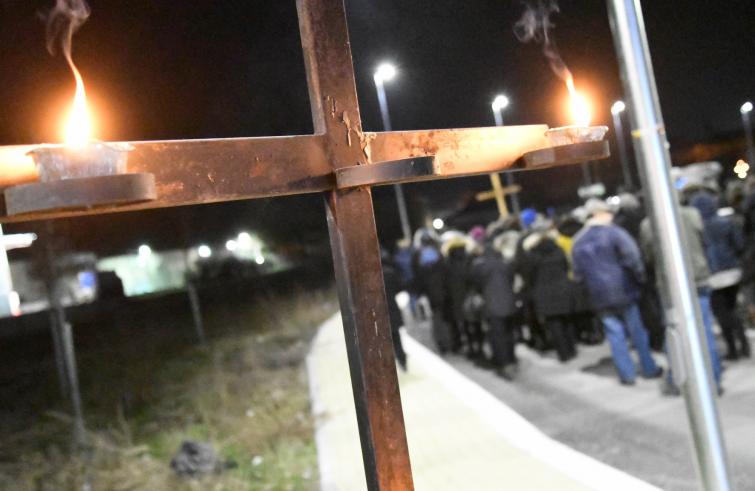
Living Lent in the Holy Land has particular flavours and meanings under many aspects.
First, there is the aspect of the Geography of Salvation, in the words of Saints Pope Paul VI and Pope John Paul II. Here, liturgical and evangelical texts characterising the Sundays of Lent and the Holy Week immediately bring to mind physical places. The desert and the Mount of Temptation are a half-hour away from Jerusalem; the site of the transfiguration is identified as Mount Tabor, in Galilee.
Even the chronicles told by Jesus as calls to conversion are here, somewhere among the archaeological remains of the Old City, and the same can be said for the court of the Temple where Jesus uttered the famous sentence that saved the adulteress’ life: “He that is without sin among you, let him cast the first stone at her”. In the Holy Week, our walk alongside Jesus takes us from Bethphage to Jerusalem and back to Bethany, and we rest in the sites of Jerusalem: the Dominus Flevit where Jesus cried upon the Holy City, the Upper Room, Gethsemane, the Church of Condemnation and Flagellation, the sorrowful path (prototype of every Via Crucis), the Golgotha, and the Holy Sepulchre.
The physicality of these places and the steps required to move from one to the other remind us that Christian life is a journey, a concrete journey, a journey in the footsteps of Jesus, a journey of conversion that forces us to progressively shed the burdens we carry, so that we can follow the Master on the path of self-giving.
Here, Lent makes us experience an ecumenical dimension that helps us to rediscover some of its aspects which have been forgotten in the West. I would like to mention two of these traits: prayer vigil and fasting. In Jerusalem, and in a very special way at the Holy Sepulchre (but not only), Lent is also characterized by prayer vigils. Saturday night becomes a continuous celebration of the Easter vigil, prayer is prolonged, and the meaning of Lent (which is precisely a journey towards Easter) is concentrated and condensed in each vigil, where one experiences the discipline of staying awake in prayer, awaiting the encounter with Jesus Christ Reborn, the encounter with the one who defeated death.
Night is no longer merely the time when darkness prevails, it is no longer about getting high, it becomes the time when candlelight defeats the gloom of darkness, when chants and prayers shatter the silence of death, when the scent of incense reminds us that love is even stronger than death.

Here, one can powerfully rediscover the sense and the value of fasting. In this respect, our Oriental brothers are very uncompromising, compared to us Westerners. For the whole duration of Lent their manner of fasting includes avoidance of all animal products (meat, eggs, milk, cheese, animal fats…). Clearly the Lenten fast is modelled on the forty-day fast which – the Gospels tell us – was practised by Jesus in the desert, and thus becomes a way to go back to basics, to go back to the desert where one can be purified by God, learn to be hungry and find nourishment in the Word of God. The oriental insistence on fasting (which is also practised by Muslims during the month of Ramadan and by Jews on several religious and national holidays) reminds us of the need to teach ourselves to be free of the our many needs (physical and social, natural and artificial), particularly so in a society based on a culture of consumption and waste. Naturally, like every evangelical proposal, this one too must be updated and personalized because each one of us needs to overcome their own addiction and free themselves from their bondage.
Sharing the experience is also important, because it makes us support each other in the journey of liberation and purification that Jesus puts forward; it makes us grow in the capacity of loving up to the gift of self-giving, it brings us to a death that contains the seed of resurrection within, which is the heart of Easter.

In the Holy land, the Lenten journey has always the flavour of the origins. The community that walked alongside Jesus on his journey to Jerusalem was a small and fragile one, so small and so fragile that the only ones who remained with Him under the Cross were his Mother, the Beloved Disciple, Mary of Magdala and Mary of Clephoas. Our Christian presence in the Holy Land continues to be a small and fragile one; many leave here because they don’t understand the value, the vocation and the mission of being Christian in the Holy Land today. Many others depart because they struggle to see a future here for their families and for their children, not realizing that the spiritual aridity of the West which they often dream of is, in a way, even harder to confront. Here, the Via Crucis through the streets of the Old City becomes a powerful reminder of the first Via Crucis which Jesus walked among the yelling and the indifference, and turns into a symbol of Christian existence in the contemporary world, which means walking in the footsteps of Jesus, who gave his life for humanity and for a world in which permanent distraction and the globalization of indifference seems to prevail. Yet a community of disciples, a delicate few, who follow Jesus on the path of self-giving, in the company of Mary and the beloved disciple, is itself a seed and a prophecy of resurrection: of a new world, of a new civilization, of a new humanity.
(*) Custos of the Holy Land










